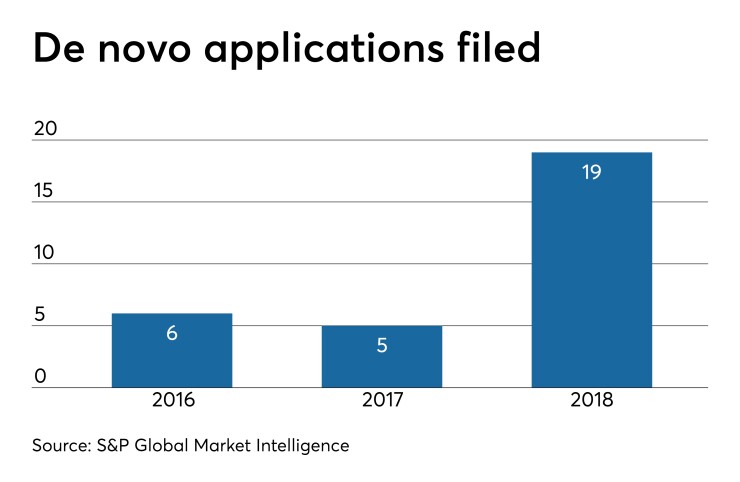After MOXY Bank received
But the de novo institution balked at the idea of using one of the larger core providers. It needed flexible virtual and mobile banking options to serve its clientele: low- and moderate-income customers in Washington, D.C. MOXY found a match in Nymbus, an alternative provider offering modern features and quick application updates.
Choosing one of the larger core providers would have meant accepting “the legacy tech they would bring on,” said Keith Walters, the chief technology officer and co-founder of MOXY Bank.
The marriage is similar to other partnerships between new banks and smaller alternative core providers, which are seeking to take market share from larger competitors by serving new banks just getting off the ground.
Alternative core providers see greater success courting de novos than trying to woo a traditional bank away from a large core provider. In turn, de novos like the modern features many alternative providers offer upfront.
“It’s an opportunity to land-grab and it’s intriguing to all of us as providers,” said Mike Hatch, vice president and national sales manager at the core banking provider Finastra.

In addition to helping MOXY establish core banking and payment solutions, Nymbus is also preparing to allow the bank to offer savings accounts, small-business accounts, lending services, financial wellness and literacy, online account opening, mobile deposit, bill pay, person-to-person payments, ATM access, text alerts and video banking services.
Through Nymbus’ application programming interfaces, MOXY eventually wants to incorporate artificial intelligence and machine learning to personalize content much like a user experiences with a streaming video service.
Nymbus also offers a single, integrated portal for clients such as MOXY to access multiple software tools that all share the same data.
When MOXY Bank launches, the de novo will offer its customers a digital branch from 8 a.m. to 8 p.m. with the goal eventually of being able to provide the service 24/7.
Nymbus’ strategy is that there will come a day when most banks, like MOXY, will want quick and flexible updates that aren’t connected to an on-site core, said Nymbus President Dave Mitchell.
“They don’t have to wait eight months to turn a new release,” Mitchell said. “If they want a new app that’s already out there, they have the ability in their own private cloud to test it and launch it to their customers. I have zero prospects in the pipeline that want this in-house anymore.”
Many de novos require real-time software and self-serve mobile platforms, said Frank Sanchez, CEO of the core banking provider Finxact. Often they are interested in niche lending markets or multiple balances in an account as well as real-time payments and settlement.
In addition to being able to plug into the latest digital banking systems, de novo banks are quicker at making operational decisions since they have only one or two executives involved in the decision process, Sanchez said. He said three de novo institutions have expressed interest in his platform, as well as fintech firms that are considering seeking a banking charter.
Hatch said the markets that de novos are interested in catering to include marijuana businesses and the underbanked.
“These executives have taken some time over the last few years to build the nest they’re looking to serve,” Hatch said.
The alternative for small core providers to marketing to new banks is to try and get existing banks to switch to their systems from a larger competitor. But this usually means the bank effectively has to stand up a digital brand on top of its old core until the bank’s contract expires or the bank is ready to switch, Mitchell said.
“You’re either converting your core or putting lipstick on a pig,” Mitchell said. “We’re able to stand digital branches in 90 days with no integration. … It’s a Trojan horse.”
But some de novo founders, particularly those who have started more than one bank, have already worked with the legacy core providers and have a sense of familiarity with them, said Lee Bradley, senior managing director at Community Capital Advisors.
“The big providers have more of a track record,” Andersen said. “I didn’t want to be a guinea pig for someone.”
Trustar plans to serve small and midsize businesses with $1 million to $50 million in revenue. Andersen’s main priority was to find a core provider that could resolve issues that have a customer impact. Jack Henry promised that that resolution takes no more than 24 hours, she said.
Hatch said while new banks are easier customers for the alternative core providers, they’re not long-term clients.
“Many times when we look at a de novo, it’s a seven- to eight-year term,” Hatch said. “They’re looking to sell or merge into another institution.”
Still, when marketing to new banks, alternative core providers can win on price and trust, Bradley said.
“Bankers will be cheap if they can get something they feel comfortable with,” he said.





